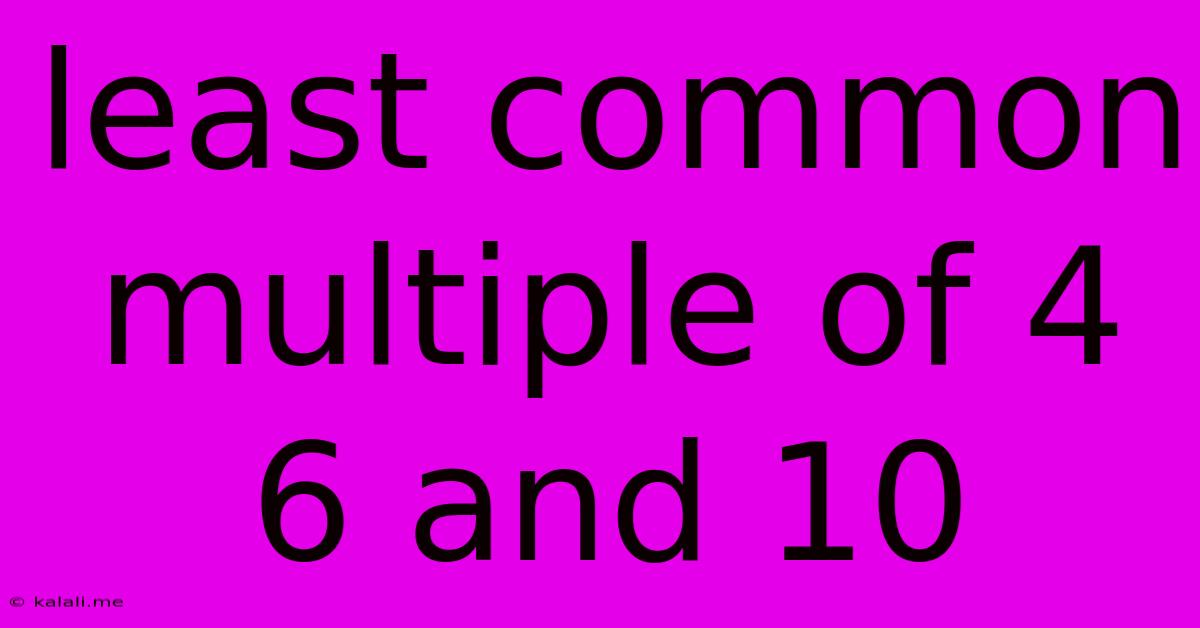Least Common Multiple Of 4 6 And 10
Kalali
Jun 12, 2025 · 2 min read

Table of Contents
Finding the Least Common Multiple (LCM) of 4, 6, and 10
Finding the least common multiple (LCM) is a fundamental concept in mathematics, particularly useful in simplifying fractions and solving problems involving cycles or repeating events. This article will guide you through calculating the LCM of 4, 6, and 10, explaining the methods involved and offering a clear understanding of the process. Understanding LCMs is essential for various mathematical applications, from simple fraction arithmetic to more complex algebraic manipulations.
What is the Least Common Multiple (LCM)?
The least common multiple (LCM) of two or more integers is the smallest positive integer that is divisible by all the integers. In simpler terms, it's the smallest number that all the given numbers can divide into evenly without leaving a remainder. This differs from the greatest common divisor (GCD), which is the largest number that divides all the given numbers without a remainder. Both concepts are crucial in number theory and algebra.
Methods for Finding the LCM of 4, 6, and 10
There are several ways to determine the LCM of 4, 6, and 10. Let's explore two common methods:
1. Listing Multiples Method
This method involves listing the multiples of each number until you find the smallest multiple common to all three.
- Multiples of 4: 4, 8, 12, 16, 20, 24, 28, 32, 36, 40, ...
- Multiples of 6: 6, 12, 18, 24, 30, 36, 42, 48, 54, 60, ...
- Multiples of 10: 10, 20, 30, 40, 50, 60, 70, 80, 90, 100, ...
By comparing the lists, we can see that the smallest number present in all three lists is 60. Therefore, the LCM of 4, 6, and 10 is 60. This method is straightforward but can become cumbersome with larger numbers.
2. Prime Factorization Method
This method is more efficient, especially for larger numbers. It involves finding the prime factorization of each number and then constructing the LCM using the highest powers of each prime factor.
- Prime factorization of 4: 2²
- Prime factorization of 6: 2 × 3
- Prime factorization of 10: 2 × 5
To find the LCM, we take the highest power of each prime factor present in the factorizations:
- The highest power of 2 is 2² = 4
- The highest power of 3 is 3¹ = 3
- The highest power of 5 is 5¹ = 5
Now, multiply these highest powers together: 4 × 3 × 5 = 60. Therefore, the LCM of 4, 6, and 10 is 60. This method is generally preferred for its efficiency and systematic approach.
Conclusion:
Both methods demonstrate that the least common multiple of 4, 6, and 10 is 60. The prime factorization method is generally more efficient and reliable, particularly when dealing with larger numbers or a greater number of integers. Understanding how to calculate the LCM is a valuable skill with applications across various mathematical fields. Remember to practice both methods to solidify your understanding and choose the method best suited to the problem at hand.
Latest Posts
Latest Posts
-
Convert Square Miles To Square Kilometers
Jun 13, 2025
-
Which Of The Following Is Not A Type Of Carbohydrate
Jun 13, 2025
-
How To Print Ticket For Act
Jun 13, 2025
-
1 Kilowatt Hour Is Equal To
Jun 13, 2025
-
Is India In The Northern Or Southern Hemisphere
Jun 13, 2025
Related Post
Thank you for visiting our website which covers about Least Common Multiple Of 4 6 And 10 . We hope the information provided has been useful to you. Feel free to contact us if you have any questions or need further assistance. See you next time and don't miss to bookmark.